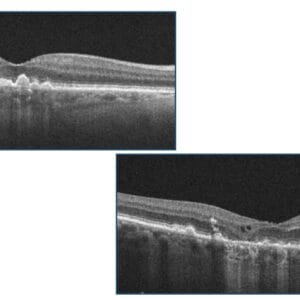January 29, 2024
The idea of personalized medicine in health care offers exciting possibilities. It uses an individual’s genetic profile to help make decisions regarding the prevention, diagnosis, and treatment of disease.
It becomes a powerful tool, especially if there is the potential to identify life-threatening health conditions that could be discovered and treated before the condition was even diagnosed. The best example of this is women, who through genetic testing, are found to have the BRACA1 or BRACA2 gene, which carries a significant risk for developing breast cancer as well as ovarian cancer.
The test has such high sensitivity and specificity for predicting who would develop breast cancer that many women with the BRACA1/2 gene are choosing to have bilateral mastectomies without even having a diagnosis of breast cancer.
What About Personalized Medicine in Eye Care?
Unfortunately, personalized medicine has yet to make its way in any meaningful way into the eye care space. Genetic testing for many inherited retinal diseases (IRD) is available and without a doubt is meaningful for those who have or are suspected to have IRD, but it’s still not mainstream and is mostly done through academic university medical settings. And the conditions for which genetic testing is performed are quite rare. Nonetheless, the information genetic testing provides for those with IRD is powerful as we are nearing the point of being able to treat some of these IRDs. Once again, the power of knowing puts patients and family members in control. For infants and school-age children it may allow earlier access to visual aids that can help optimize learning.
This has all become possible through data from the Human Genome Project. The Human Genome Project is considered “one of the greatest scientific feats in history. The project was a voyage of biological discovery led by an international group of researchers looking to comprehensively study all the DNA (known as a genome) of a select set of organisms. Launched in October 1990 and completed in April 2003, the Human Genome Project’s signature accomplishment – generating the first sequence of the human genome.”1
Genetic Testing for AMD
Through these scientific breakthroughs, investigators discovered over 30 genes associated with the risk of developing age-related macular degeneration (AMD). Of the 30 genes, two have been more closely connected with AMD and confer a higher risk of progressing to the advanced stages of AMD.2 They are the complement cascade genes that help regulate complement factor H (CFH) and are located on chromosome 1. The other is the ARMS2/HTRA gene, which regulates oxygen metabolism and is located on chromosome 10. The presence of these gene variants doesn’t necessarily mean that an individual will develop AMD, but it does put them at a higher risk. Other factors such as lifestyle, age, diet, smoking, among others are also significant factors that increase the risk of developing AMD.
When you consider that AMD is one of the leading causes of vision loss in the United States and nearly two million people have advanced AMD, wouldn’t genetic testing be a powerful tool in helping a person know if they had any of the key genes that would put them at risk for developing AMD? Wouldn’t this be especially beneficial for family members who have watched parents or grandparents suffer with the debilitating effects of AMD. The fact is genetic testing is available and accessible thanks to the Human Genome Project and the commercialization of genetic testing that now allows for direct-to-consumer (DTC) testing.
Perhaps the most popular DTC test is 23andMe, which tests for the two key AMD genes (the Y402H variant in the CFH gene and the A69S variant in the ARMS2 gene). The company points out that the test does not diagnose AMD (or any other health condition), and it does not test for all the genetic variants of AMD. The macular degeneration report is available on the Health + Ancestry Service and 23andMe +.
The big concern with DTC genetic testing for macular degeneration is interpretation. Just because you have some of the key genes doesn’t mean an individual will develop AMD because it is a complex disease and other variables play a role. The fact is, we don’t even know the baseline risk of developing macular degeneration in people who don’t have any genetic variants. For those who do, we don’t know how the genetic variants interact with each other and the environment. So, genetic testing identifies individuals who are at risk and at best, allows them to be proactive.3 That could mean more frequent exams; more than once a year for those who appear to be at a higher risk. Even home monitoring may be an option for those who are already showing signs of AMD. For a patient who is only presbyopic who otherwise wouldn’t come in to get their eyes tested, that information alone may be enough to prompt them to get examined at least once a year. Being proactive may also be the motivation for people to stop smoking and improve their diet by including more fish and green leafy vegetables.
There are at least two genetic testing laboratory companies with a focus on AMD, and both are trying to work more closely with the eye care community as a means of identifying at risk people but trying to do it in a way that is more responsible to the patient. The goal is to make the eye care provider part of the equation so they can identify appropriate patients for genetic testing but also to help put genetic testing results in perspective for the patient. It also allows for a more personalized approach to managing each patient based on their genetic risk. Both genetic testing laboratories test for many more genetic mutations for AMD than 23andMe.
Visible Genomics offers two different testing kits, the AMDiGuard DNA Risk Test and the AMDiGuard DNA Progression Test.4 The progression test is recommended for those who have early or intermediate AMD and provides a risk score for progression to advanced AMD in people over the age of 55. The DNA risk test is recommended for patients under 55 with a family history of AMD and provides a lifetime risk level of progressing to advanced AMD. Each test is $179 but has a provider discount of $149. Both tests can be ordered directly from the company without having consulted an eye care provider, however, each test result is reviewed internally by a physician.
Arctic Medical Laboratories also offers two different genetic tests. Macula Risk is the fundamental genetic test that determines if a patient has the key AMD genes with the goal of identifying high risk patients so there can be increased surveillance. The Vita Risk genetic test looks at the role that zinc-containing supplements play in increasing the risk for progression of AMD. Arctic has conducted research that shows higher concentrations of zinc contained in some nutritional formulations may increase the risk of progression of AMD in individuals with CFH genetic variants. For those who have a CFH mutation, supplements containing lower concentrations, or even no zinc, is recommended, according to Arctic.5 The results of those studies have been controversial.
Where Does That Leave Us?
Genetic testing for AMD is readily available and affordable via DTC companies such as 23andMe or through more AMD-specific genetic testing companies through Visible Genomic or Arctic Medical Laboratories. So, why isn’t genetic testing for AMD more widely adopted?
Perhaps it is with 23andMe, but because it falls outside of what the scientific community has access to, we just don’t know. Moreover, 23andMe can test and identify so many other at risk genetically mediated health conditions, including BRACA1/2, that AMD does not seem that significant compared to everything else, especially for younger individuals who aren’t aware of the significance of AMD. No doubt, by now, as eye care providers we have all had patients in our chairs who have taken the 23andMe test and have come in with questions and concerns around AMD.
Maybe even more important is that the American Academy of Ophthalmology (AAO) and the American Society of Retinal Specialists (ASRS) have both provided position statements recommending against genetic testing for AMD. That to date, the AAO claims that information from genetic testing has not been shown to improve the early diagnosis beyond a standard comprehensive eye exam and that altering the management of high-risk individuals (based on genetic testing results) has not resulted in better visual outcomes compared to the overall lower risk for progression. The ASRS states that because dry AMD is not treatable and because gene therapy is not available for prevention or management of the disease, there is no benefit from identifying which genes are involved in any individual’s case of macular degeneration.
When all is said and done, it comes back to the patient. There are those who want to know, and maybe even do know, via DTC companies. For others who have seen family members suffer from AMD, it is important to let them know that genetic testing is available and provides them with the necessary information so they can make the appropriate decision that best serves them and their curiosity.
References
1 The Human Genome Project. National Human Genome Research Institute
2 Mukamal, R. Genetics and macular degeneration. American Academy of Ophthalmology Eye Health A-Z. January 19, 2023.
3 Hartz SM. My experience with direct-to-consumer testing. Narrat Inq Biotech. 2015; 5(3):208-210
4 Macular Degeneration AMD Genetic Testing. Visible Genomics
5 Arctic Medical Laboratories. Genetic research reveals that zinc-based eye vitamins like AREDS/AREDS2 used to prevent the progression of age-related macular degeneration (AMD) are not safe for 15% of patients.





